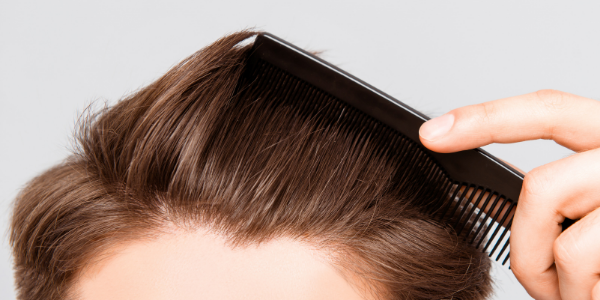
How to Avoid Hair Loss on TRT

If you’re considering TRT, you may be wondering about the impact of TRT on hair loss.
While TRT doesn’t directly cause hair loss, increased Testosterone can lead to androgenic alopecia if the patient has a genetic sensitivity to the hormone DHT (dihydrotestosterone).
Androgenic alopecia is also known as male-pattern baldness and female-pattern baldness. It’s the most common cause of hair loss in men and women.
We’ll discuss how to avoid hair loss when starting a TRT protocol.
Diagnosing Your Androgenic Alopecia
The first step to avoiding hair loss on TRT is to identify whether you have a genetic sensitivity to DHT. If you don’t, then it’s unlikely that TRT (and a resulting increase in DHT levels) will trigger hair loss.
Testosterone and DHT are interlinked, and when T levels rise, DHT levels typically rise as well.
Male-pattern baldness most often occurs in an M-shaped pattern starting at the forehead. It may also manifest as a slowly widening bald spot on the crown of the head. If you notice either of these patterns in your hair, then it’s possible you have male-patterned baldness.
There are other causes of hair loss, including certain lifestyle habits like smoking, lack of adequate nutrition, and chronic stress. Examine your lifestyle to see if these factors may be impacting your hair.
Because androgenic alopecia is a genetic condition, you can also look at your family line for any signs of hair loss, as well. A common myth is that hair loss is inherited from the mother’s side, but in actuality, both parents can pass down the genes that lead to androgenic alopecia. This condition is polygenic, meaning it comes from multiple genes rather than just one.
It’s useful to work with a knowledgeable provider when diagnosing androgenic alopecia. Defy Medical offers consultations to discuss this topic in detail.
DHT Blood Testing
If you’re experiencing hair loss but aren’t sure it’s androgenic alopecia, or if you don’t have any symptoms but still want to check, you can order a DHT blood test. This test measures your DHT levels to determine whether your levels are elevated. Elevated DHT levels along with hair loss often indicate androgenic alopecia.
How to Avoid Hair Loss on TRT
If you do have androgenic alopecia, there are several treatment options to slow and minimize hair loss.
It’s important to catch hair thinning and hair loss as quickly as possible, so you can preserve hair follicles. It’s much more effective to slow hair loss than to grow hair back after it’s gone.
Finasteride (Propecia)
Finasteride is used either orally or topically to slow the production of DHT. It does this by inhibiting the enzyme 5-alpha-reductase, which converts Testosterone into DHT.
While it’s often successful at slowing hair loss, it can also impact hormone production. This can lead to hypogonadism and other side effects in men, and it’s not recommended for women.
Defy Medical provides products containing Finasteride, but we recommend utilizing topical Finasteride rather than oral medication, since the former does not impact hormones in the same way. We also suggest exploring some of the less severe options below first.
Minoxidil
Minoxidil is a widely available non-prescription treatment for hair thinning. It stimulates the growth of new hair by improving the blood supply to shrinking hair follicles.
When used in the early stages of alopecia, it can be effective as a standalone treatment and is considered safe for most people.
Latanoprost
Latanoprost imitates prostaglandins, which have shown promise in promoting hair follicle growth. In studies, latanoprost increased hair density in young male participants who had minor hair loss.
Like many other hair loss treatments, Latanoprost works best when used as soon as possible after hair loss begins.
Ketoconazole
Despite being primarily an antifungal cream, Ketoconazole has demonstrated potential in mitigating the impacts of dihydrotestosterone (DHT) on the scalp. Evidence suggests that Ketoconazole blocks DHT from shrinking hair follicles.
Spironolactone
Spironolactone’s primary use is to alleviate edema (water retention), but it’s also prescribed to women for female-pattern baldness.
This medication aims to decrease the levels of Testosterone and other androgens produced by the ovaries and adrenal glands, which in turn decreases DHT levels.
Spironolactone can be administered as an oral tablet or topical solution.
Azelaic Acid
Azelaic Acid is a naturally occurring antibiotic that has shown potential in limiting 5-alpha-reductase activity in the skin. This may lead to a decrease in DHT levels, which helps ease androgenic alopecia symptoms.
Browse Hair Loss ProductsPRP Scalp Injections
Platelet-Rich Plasma (PRP) injections are a promising therapy for hair loss. PRP can potentially boost hair growth by delivering healing growth factors directly to hair follicles.
The treatment involves using a sample of your own blood, which is processed to obtain the highest concentration of platelets and growth factors. The PRP mixture is then injected throughout the scalp for a comprehensive treatment.
PRP injections are particularly beneficial for individuals with thinning hair who have not yet experienced bald spots. Defy Medical provides PRP injections as a hair loss solution at our clinic in Tampa, FL.

How to Avoid Hair Loss on TRT
As we’ve explained, TRT may trigger hair loss if you have a genetic sensitivity to DHT. This is the most common cause of hair loss in men and women, and it’s called androgenic alopecia.
Because the symptoms of low Testosterone can be debilitating, many men still pursue TRT treatment even if they experience androgenic alopecia. For those patients, Defy Medical offers access to a wide range of hair loss therapy options.
You can access our comprehensive care through convenient telemedicine consults and online ordering of medications.
Ready to learn more?
Get Started

